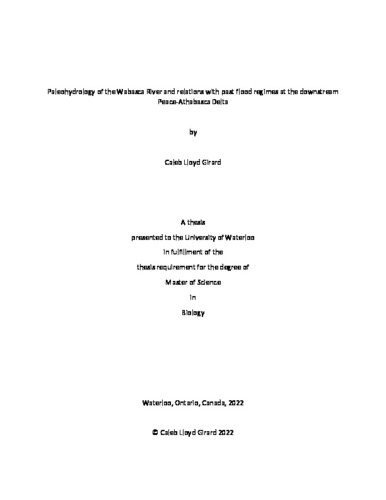| dc.description.abstract | The Peace-Athabasca Delta (PAD; northern Alberta) is internationally recognized for its ecological, historical, and cultural significance, yet controversy persists over the roles of hydroelectric regulation of Peace River flow versus climate on reduced ice-jam flood influence and drawdown of water levels in the delta’s abundant perched lakes. The unregulated Wabasca River, located ~350 river-km upstream, is a key ‘trigger tributary’ for generation of ice-jams on the Peace River that flood the PAD, yet its long-term influence remains poorly understood due to a paucity of hydrometric data. Here, past variation in Wabasca River flood influence is reconstructed using paleolimnological analyses on sediment cores from two oxbow lakes (WAB 1, WAB 2) adjacent to the Wabasca River that flood likely when spring discharge is high and ice-jams form. Results are compared to paleohydrological records from two oxbow lakes near the Peace River at the PAD to infer the extent to which variation in regional hydroclimatic conditions influence shifts in flood regimes at the PAD. Stratigraphic analyses at oxbow lake WAB 1 revealed the lake is too flood-prone to detect marked temporal variation in flood influence. Stratigraphic profiles of mineral matter content from loss-on-ignition analysis, trace element concentration from X-ray fluorescence analysis, and grain size distribution at WAB 2, however, reveal four zones of marked variation in flood influence during the past ~250 years. Sediment deposited during Zone 1 (~1765-1825) and Zone 3 (~1880-1930) possesses relatively high mineral matter content and high concentrations of elements indicative of detrital input and is interpreted to record intervals of relatively strong flood influence associated with high spring discharge on the Wabasca River. In contrast, sediment deposited during Zone 2 (~1825-1880) and Zone 4 (~1930-2019) consists of lower mineral matter content and lower concentrations of elements indicative of detrital input and is interpreted to reflect intervals of weaker flood influence and lower spring discharge. Correspondence of the zone boundaries identified at WAB 2 with changes in stratigraphic variation in magnetic susceptibility of sediment at the two oxbow lakes in the PAD identifies that variation in hydroclimate has been an influential driver of flood regimes at both the Lower Wabasca River and the Lower Peace River at the PAD for at least the past ~250 years. Sediment records from all three oxbow lakes reveal that flood influence began to decline since at least ~1930, several decades before regulation of Peace River flow by the W.A.C. Bennett Dam. Furthermore, the 20-year interval (~1975-1995) without major ice-jam floods at the PAD since regulation of the Peace River by the W.A.C. Bennett Dam coincides with a shift to consistently low maximum single-day spring discharge on the Wabasca River, a decrease in snowpack depth within much of the Wabasca and Peace river basins, an interval of consistently low mineral matter content and low concentrations of detrital elements in the sediment core from WAB 2, and an interval of low C/N ratios in sediment cores from the two oxbow lakes in the PAD. This provides further evidence of the strong role of climatic conditions on the hydrological regimes of both rivers during spring of the W.A.C. Bennett Dam era. This information can enable environmental stewardship by focusing mitigative and adaptive decisions towards anticipated effects of future climatic conditions. | en |

